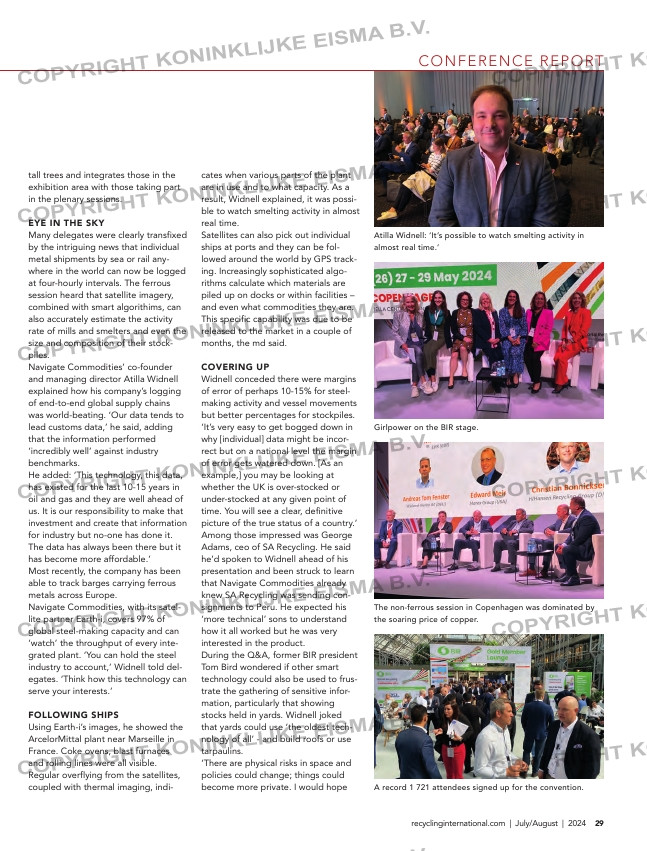Page 29 from: What’s inside issue #4?

CONFERENCE REPORT
29recyclinginternational.com | July/August | 2024
tall trees and integrates those in the
exhibition area with those taking part
in the plenary sessions.
EYE IN THE SKY
Many delegates were clearly transfixed
by the intriguing news that individual
metal shipments by sea or rail any-
where in the world can now be logged
at four-hourly intervals. The ferrous
session heard that satellite imagery,
combined with smart algorithims, can
also accurately estimate the activity
rate of mills and smelters and even the
size and composition of their stock-
piles.
Navigate Commodities’ co-founder
and managing director Atilla Widnell
explained how his company’s logging
of end-to-end global supply chains
was world-beating. ‘Our data tends to
lead customs data,’ he said, adding
that the information performed
‘incredibly well’ against industry
benchmarks.
He added: ‘This technology, this data,
has existed for the last 10-15 years in
oil and gas and they are well ahead of
us. It is our responsibility to make that
investment and create that information
for industry but no-one has done it.
The data has always been there but it
has become more affordable.’
Most recently, the company has been
able to track barges carrying ferrous
metals across Europe.
Navigate Commodities, with its satel-
lite partner Earth-i, covers 97% of
global steel-making capacity and can
‘watch’ the throughput of every inte-
grated plant. ‘You can hold the steel
industry to account,’ Widnell told del-
egates. ‘Think how this technology can
serve your interests.’
FOLLOWING SHIPS
Using Earth-i’s images, he showed the
ArcelorMittal plant near Marseille in
France. Coke ovens, blast furnaces
and rolling lines were all visible.
Regular overflying from the satellites,
coupled with thermal imaging, indi-
cates when various parts of the plant
are in use and to what capacity. As a
result, Widnell explained, it was possi-
ble to watch smelting activity in almost
real time.
Satellites can also pick out individual
ships at ports and they can be fol-
lowed around the world by GPS track-
ing. Increasingly sophisticated algo-
rithms calculate which materials are
piled up on docks or within facilities –
and even what commodities they are.
This specific capability was due to be
released to the market in a couple of
months, the md said.
COVERING UP
Widnell conceded there were margins
of error of perhaps 10-15% for steel-
making activity and vessel movements
but better percentages for stockpiles.
‘It’s very easy to get bogged down in
why [individual] data might be incor-
rect but on a national level the margin
of error gets watered down. [As an
example,] you may be looking at
whether the UK is over-stocked or
under-stocked at any given point of
time. You will see a clear, definitive
picture of the true status of a country.’
Among those impressed was George
Adams, ceo of SA Recycling. He said
he’d spoken to Widnell ahead of his
presentation and been struck to learn
that Navigate Commodities already
knew SA Recycling was sending con-
signments to Peru. He expected his
‘more technical’ sons to understand
how it all worked but he was very
interested in the product.
During the Q&A, former BIR president
Tom Bird wondered if other smart
technology could also be used to frus-
trate the gathering of sensitive infor-
mation, particularly that showing
stocks held in yards. Widnell joked
that yards could use ‘the oldest tech-
nology of all’ – and build roofs or use
tarpaulins.
‘There are physical risks in space and
policies could change; things could
become more private. I would hope A record 1 721 attendees signed up for the convention.
Atilla Widnell: ‘It’s possible to watch smelting activity in
almost real time.’
Girlpower on the BIR stage.
The non-ferrous session in Copenhagen was dominated by
the soaring price of copper.
28-29-30-31-32-33_birreport.indd 29 04-07-2024 08:54



